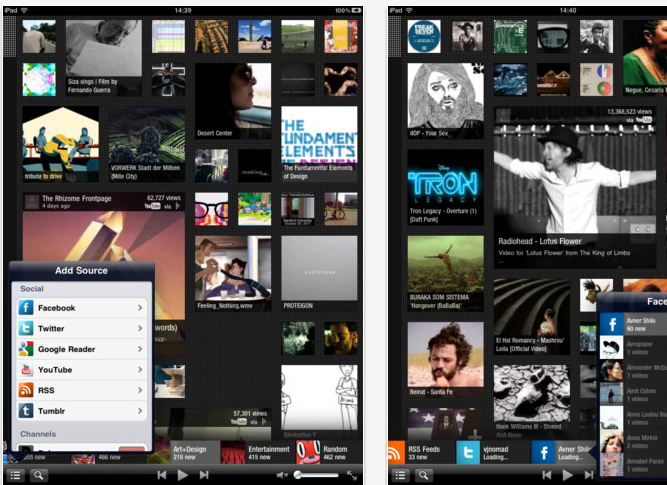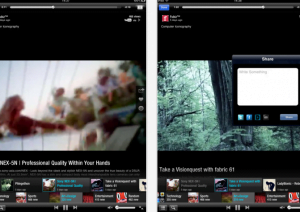There are a multitude of apps trying to conquer the mobile video space. Israeli startup Deja is one that focuses on a “lean-back” TV experience that requires minimum friction with its users.
Contrary to YouTube’s search-and-click viewing experience, Deja seeks to give users an effortless streaming of channels and videos drawn from all across the web, based on users’ interests, friends and mood.
The “lean-back” experience
Deja, pronounced like the French term ‘déjà vu,’ provides users with curated channels of content from across the web. When users enter the app, they can click the list icon on the bottom left corner to open a menu of sources from which to stream content. The sources include Facebook, Twitter, Google Video, YouTube, RSS feeds and Tumblr – with the option of connecting multiple accounts.
Besides the simple search tool, there are also pre-programmed channels such as Comedy, Art, Documentary, Gaming and Fashion. As a user, if you especially like the video you’re watching, you can use the target-shaped icon on the right to stream related videos to the one currently being watched – as opposed to the channel originally chosen.
For example, you can search the term ‘Olympics’ under the RSS feeds and find your preferred news network’s Olympic update page. From there you can sit back, relax, and enjoy Olympic coverage as though you were watching television. Videos continue to play without the need for you to choose a new one, providing a “lean-back” experience.
Related Stories:
- Vodio Helps You Discover The Videos You Want To Watch
- New Search Engine Says It Will Do To Video What Google Did For Text
So how can we find the content we like? One way is to watch the video’s recommended by our friends in social network platforms. But come to think of it, people don’t actually choose their friends based on video-viewing preferences. The chances of enjoying an eclectic stream of interesting content from our friends’ videos are quite slim.
Nimrod Ram, Deja’s CEO and Co-Founder, tells NoCamels how their idea came up. “We were playing with the idea of aggregating social content a long time ago. We realized pretty early on is that social is not enough.” To answer this, Deja began supplementing pure pre-created channels of content taken from blogs and other sites across the web.
The idea is not unique to Deja. Another Israeli company, Vodio, presents columns of content based on topics, and constantly adapts to users’ personal taste. But while Vodio focuses on finding relevant content and providing recommended videos, Deja focuses on the viewing experience. According to Deja, their platform is not only for discovering new content, but also for providing its users with a video-streaming experience that emulates watching a channel on television.
Sourcing videos from all over the web provides more than enough channels to choose from based on what the user feels like watching at that moment.
“We [realize] that people want as little friction as possible between themselves and good content. They want to turn it on and be entertained.” Ram explains. He adds: “You don’t have to start searching, you don’t have to start describing, you don’t have to start following people to get good content.”
Sign up for our free weekly newsletter
SubscribeDeja’s “secret sauce”
Deja collects text from video comments on YouTube, blogs and social networks, analyzes it through natural language processing, and determines different emotions in the users’ comments. This process is called emotional classification, what Ram refers to as Deja’s “secret sauce.” The claim is that with relative accuracy they can determine whether the user who wrote the comment is happy, sad, annoyed, and so on. This provides the foundation for building channels.
Similarly, the startup Jinni also makes use of natural language processing (among other algorithms) to recommend TV shows and movies to users based on search input related to the user’s mood. Deja uses the technology to create and curate channels of content that users can immediately view, as opposed to recommendations that users must then pursue elsewhere to watch.
Community curatorship
While their core service is video consumption, Ram introduced his vision of “community curatorship” – people curating and programming channels for others. “Why watch the National Geographic if I can watch 100 sub-channels only on bears, or only on owls, or only on icebergs?” Ram added, explaining that such sub-channels would be curated by enthusiasts, leading users to more interesting content. The ideal is as follows: as opposed to experiencing a readymade collection of videos or a stream of content from your friends, you could explore specific channels of interest created by passionate users who care to produce an accurate, elaborate channel on the subject.
The Deja team, which came together in March 2010, consists of Nimrod Ram and Avner Shilo. To date the company is self-funded and is focusing on generating users.
The free app is currently compatible with iPhones and iPads. Deja will soon be compatible with Android and GoogleTV as well. In addition Deja has started negotiating with hardware manufacturers about becoming an original equipment manufacturer (OEM) on their devices.
Last year Deja got exposure at TechCrunch Disrupt with their Startup Battlefield presentation [see video below]. This year Deja spent 10 weeks with Israeli startup accelerator UpWest Labs in Silicon Valley. There they were introduced to the GoogleTV, which made Ram realize the importance of becoming, in his words, “more connected to the devices.” Looking into GoogleTV led the Deja team to participate in the GoogleTV Hackathon, which they went on to win. Winning earned the team an invite to participate in Google I/O, where they presented the Beta of their app for the GoogleTV.
Deja is based both in Silicon Valley and in Tel Aviv. For the future, Ram anticipates Deja’s management team based in the United States and development team based in Israel.
Their business relies heavily on advertising: “Commercials have been holding up the TV this way for 60-70 years, and we can use the same model,” Ram said, “People are used to getting commercials between videos.”
Related posts

Editors’ & Readers’ Choice: 10 Favorite NoCamels Articles

Forward Facing: What Does The Future Hold For Israeli High-Tech?

Impact Innovation: Israeli Startups That Could Shape Our Future





Facebook comments